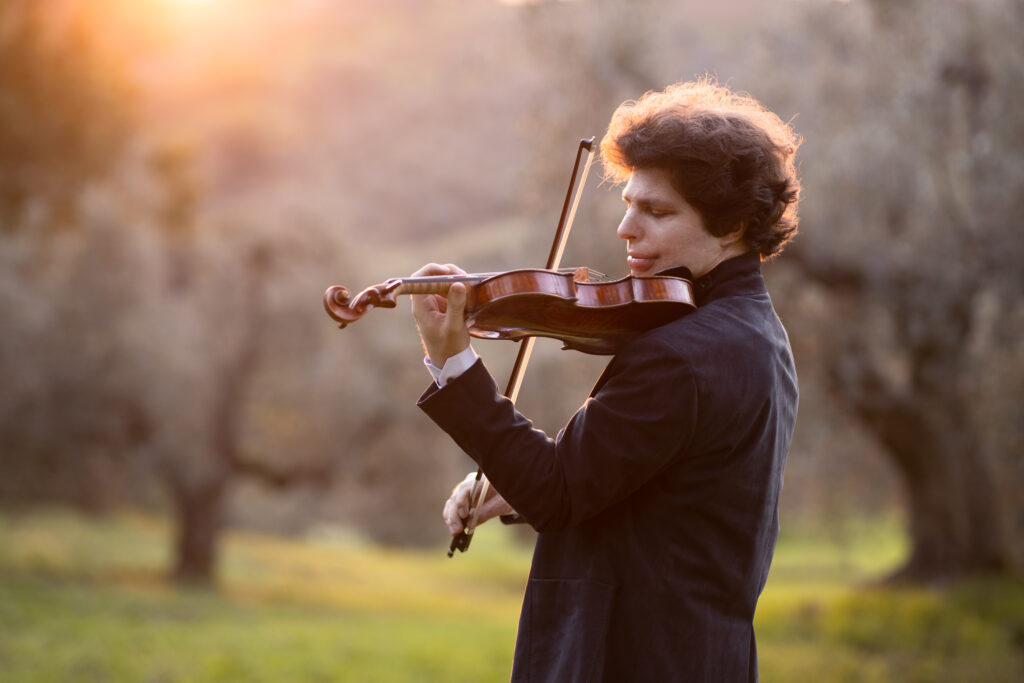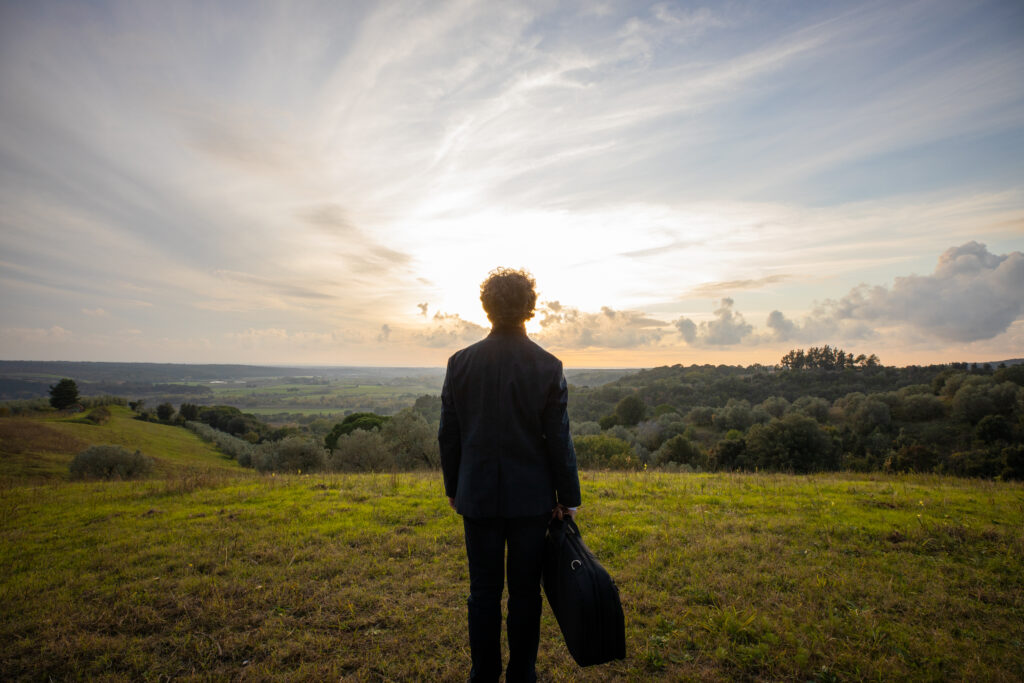Violin vs. Piano – Interview with Augustin Hadelich
Listening to star violinist Augustin Hadelich the words of George Bernard Shaw come to mind, advising the young Jascha Heifetz to play something badly every night before going to bed, instead of saying prayers, as not to provoke a jealous God by ‘playing with such superhuman perfection’.
And Zlata Chochieva, famous for her recording of the complete Chopin Etudes, commented that Hadelich’s performance of a Nocturne on the violin was ‘the most beautiful Chopin’ she ever heard. PIANIST talked to Augustin Hadelich, who happens to be an excellent pianist as well, about his love for the violin and the piano.

– You played both violin and piano from a very early age.
– Yes, I always played the piano, but the violin was the ideal instrument for me. I love the sound, the singing quality. I was always more serious about studying the violin. Although I had great teachers for the violin, I was mostly self-taught on the piano. After playing the piano throughout my childhood and studies, during the last ten years I became so busy concertizing on the violin that I didn’t have much time to play piano. That changed during the pandemic —I took up the piano again and it came back quickly.
– You did many videos on YouTube playing both instruments.
– My parents-in-law have a digital piano on which I could record the piano part easily. I started with the Rachmaninoff Vocalise. It was easy to combine the two parts, as the piano is playing the whole time and is driving the flow, so it was easy to play the violin in sync to my piano recording. With other pieces, I had to first figure out what timing I wanted to do on the violin before recording the piano part – or sometimes even record the violin part first. I love Kreisler’s piano parts, because there are always wonderful, tasteful details happening in the piano part of his pieces. He was a good pianist himself. Wieniawski’s piano parts are not as interesting. I think you can tell how well a composer must have played the piano! Some pieces I recorded in sections and then it became quite a puzzle. But it was fun, and collaborating with myself in this way made me feel I was playing with someone, which was nice because I felt kind of lonely musically during the start of the pandemic. I have to say though that despite all that, I missed the adrenaline of being on stage. Corona made us realize how much better live performances are compared to recordings.

– You think piano playing is helpful for a violinist?
– Yes. Many violinists focus mostly on the top line. They do hear the rest, but a pianist automatically is much more aware of the harmonies, the structure, counterpoint, polyphony and voice leading, all those important things that are so incredibly useful when you are trying to understand why something is written the way it is. I learned a lot from conductors in that respect too.
– What about the other way round?
– I have known pianists who played some violin and they all had a beautiful touch. Perhaps because they searched on the piano for a more violin-like sound quality, for a singing tone that’s not too percussive.
– Arthur Grumiaux and Clara Haskil each played both piano and violin and sometimes they switched instruments, could you do the same?
– That’s interesting! I know Julia Fischer plays both instruments too. I would not compare myself to a great pianist. For example, I don’t understand how some the more virtuoso music is played. But I can play well enough to enjoy myself a lot of my favorite repertoire for piano – for example the Beethoven piano sonatas (except the Hammerklavier). The violin sonatas are great, but the piano sonatas are I think on another level. Anyway, although I was never taught to be a professional pianist, much of what I learned about musicality and phrasing on the violin, applies to playing the piano as well. That being said, to be in technical control you have to practice so much!
I was recently asked to play in one concert a Mozart violin concerto plus a piano concerto. I really wanted to do it, but I would be so nervous for the piano concerto! 15 years ago, I used to be very nervous playing the violin in concert. This improved gradually, and I now have the kind of confidence with the violin that when I step on a stage I feel like I’m home. But it takes years to get there, and I think if I perform piano it would feel quite different!
– Although the piano repertoire is, as you say, so rich, pianists still have the urge to expand it.
– Yes, there is so much written for piano, there is not even enough time in life to hear everything. Some of the repertoire, like the Godowsky Chopin Etudes or Liszt Don Giovanni, I sometimes ask myself, do we need it? (the same could be said about some of the violin repertoire!) I know it’s so impressive technically, but when I listen to a piano recital or sit down to play something for myself at the piano, I want to explore the incredible riches of Bach, Scarlatti, Chopin, Schubert and so on.
I noticed that pianists often seem to specialize in a certain repertoire, or might even feel pressure to specialize — for example concentrating on Beethoven, or on French music or on the Russians. Among violinists this is not common at all. Perhaps because our repertoire is a bit smaller, violinists tend to kind of play a bit of everything. I like that about the violin, the variety of repertoire that I get to play.
– You played Chopin’s Nocturne in c sharp minor, arranged by Nathan Milstein for violin.
– I first played this Nocturne on the piano, and I loved it so much. But I think the transcription works surprisingly well. I would not say it is better on the violin, but the lyricism of the line comes out beautifully. But I know some pianists can make it sound very lyrical on the piano too. The end of the Nocturne is more difficult on the violin. If you’re not careful, the runs up and down at the end of this Nocturne can sound as if you are practicing scales on the violin, and can sound tedious, whereas on the piano it’s easier to make those scales can sound wonderfully light. That is a problem with many transcriptions, some parts work well and some parts just don’t. I spent a lot of time working on the ending of this violin transcription, trying to make those runs sound as light and crystal-clear as they do in the piano version.
– What do you think of the piano transcription Beethoven made of his violin concerto?
– Maybe I’m opinionated because I’m a violinist, but I don’t like it as much as the violin version. I think the music is written with the violin sound in mind! Beethoven might have transcribed it because the violinist at the premiere didn’t play the concerto so well and the reception to the piece was mixed. Whenever Beethoven or Brahms or other great pianist-composers write for violin, it’s pretty obvious that they are still thinking of the keys of the piano! For example in the Beethoven concerto it’s much easier to play the solo passagework on the piano keys than on the violin strings. Even during the very first entrance of the violin, the descending figures, which are easy to play on the piano, are extremely hard on the violin — you have to “crawl” down in a way that’s quite unusual. The simplest way to explain it is this: on the piano, you use five fingers to play, but on the violin, we use only four because the left thumb is supporting the neck of the violin. So, a lot of themes or ideas conceived by pianists require awkward shifts when played on the violin, because we have one fewer finger to use!
The music of the Beethoven concerto is divine, of course. There is a moment in the slow movement where time seems to stand still and we get transported somewhere else. The music gets extremely soft, and it’s just the violin line playing the theme up high and a few plucked notes in the strings underneath as it gets softer and softer. I think most composers would not have the courage to write so few notes into the score, and they wouldn’t have the genius to create so much with so little. I put an excerpt of a recent performance on YouTube, cut in a way that you can endlessly repeat this very special moment of the piece – because when I play it, I feel transported and never want to move on! These kinds of moments are what music is all about.
YouTube: Augustin Hadelich – Beethoven concerto (2nd mvt), Peter Oundjian, Colorado Music Festival Orchestra
Winning the gold medal and a bunch of special prizes at the 2006 International Violin Competition of Indianapolis launched his career even before he graduated from Juilliard.
Augustin Hadelich was named the 2018 “Instrumentalist of the Year” by Musical America and he currently performs on a Guarneri del Gesù, once played by Henryk Szeryng. His last recording of the Bach Sonatas & Partitas was released in 2021.
This article is a contribution from the German and Dutch magazine Pianist through Piano Street’s International Media Exchange Initiative and the Cremona Media Lounge.
 Pianist Magazine is published in seven countries, in two different editions: in German (for Germany, Austria, Switzerland, Luxemburg and Liechtenstein) and in Dutch (for Holland and Belgium).
Pianist Magazine is published in seven countries, in two different editions: in German (for Germany, Austria, Switzerland, Luxemburg and Liechtenstein) and in Dutch (for Holland and Belgium).
The magazine is for the amateur and professional alike, and offers a wide range of topics connected to the piano, with interviews, articles on piano manufacturers, music, technique, competitions, sheetmusic, cd’s, books, news on festivals, competitions, etc.
For a preview please check: www.pianist-magazin.de or www.pianistmagazine.nl
Comments
A simply amazing recording. Thank you. Your vibrato is magic
It is fascinating to hear the perspective of a musician who excels at two different instruments, and it will be interesting to see how Hadelich continues to develop and explore his talents on both the violin and the piano.